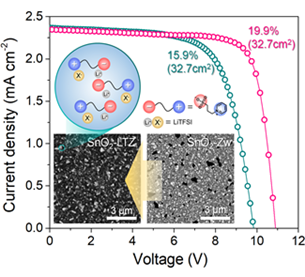
연구
Research Outcome
미래를 창조하는 포스텍 화학공학과
Modulating Molecular Interaction of Zwitterion Toward Rational Interface Engineering of Perovskite Solar Cells
- Title of paper
- Modulating Molecular Interaction of Zwitterion Toward Rational Interface Engineering of Perovskite Solar Cells
- Author
- [박태호 교수 연구실] 양쪽성 이온의 응집 조절을 통한 페로브스카이트 태양전지 계면층 기술 개발
- Publication in journal
- Advanced Energy Materials
- Publication date
- 20240520

{Abstract]
Passivation of perovskite crystals is a crucial strategy to improve the efficiency and stability of perovskite solar cells (PSCs). Zwitterions, which contain both positive and negative charges in the molecule, can be used to passivate perovskite crystals. However, these materials strongly interact with each other, resulting in extremely low solubility in common organic solvents. The low solubility of zwitterions hinders the formation of uniform films, which negatively affects perovskite crystal growth. In this study, a liquid-type zwitterion (LTZ) is synthesized by modulating intermolecular interactions of the zwitterion (3-(1-Pyridinio)-1-propanesulfonate). By suppressing intermolecular interactions, the solubility and processibility of the zwitterion in common organic solvents are successfully improved. The well-distributed LTZ-treated films are obtained, resulting in better electrical properties for the PSCs compared to solid-type zwitterion-based devices. With these characteristics, the resulting device achieves a power conversion efficiency of 24.9% with excellent thermal stability (under 60 °C and N2 atmosphere), maintaining over 80% of its initial efficiency for 1968 h. In addition, the PSC module (active area of 32.7 cm2) achieves an improved efficiency of 19.86% with high open-circuit voltage and fill factor. The results suggest that interface engineering with an LTZ has the potential to fabricate efficient and stable PSCs.
DOI: https://doi.org/10.1002/aenm.202401263
Link: https://onlinelibrary.wiley.com/doi/10.1002/aenm.202401263



